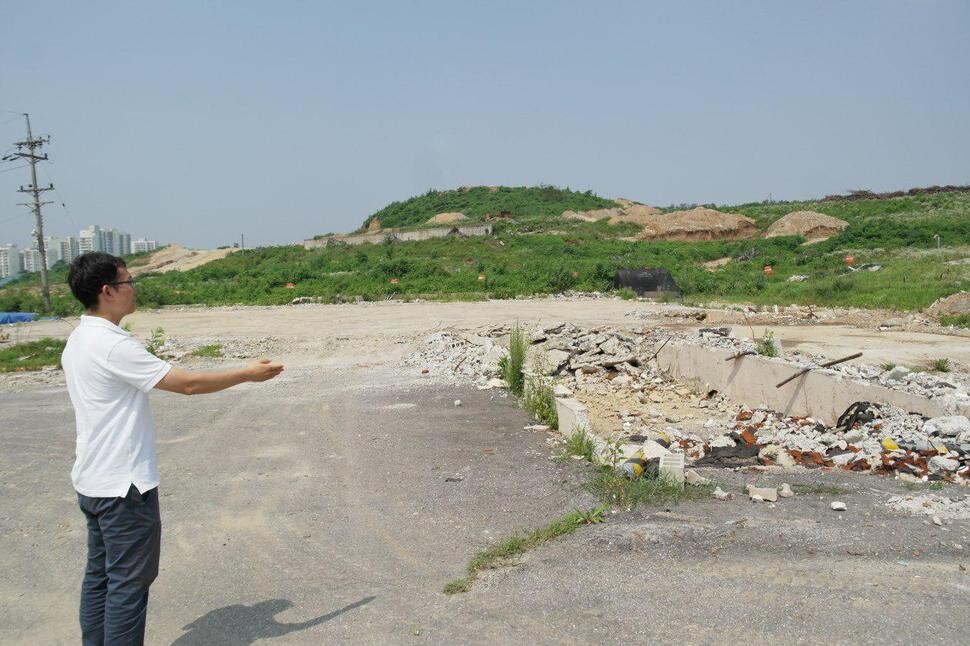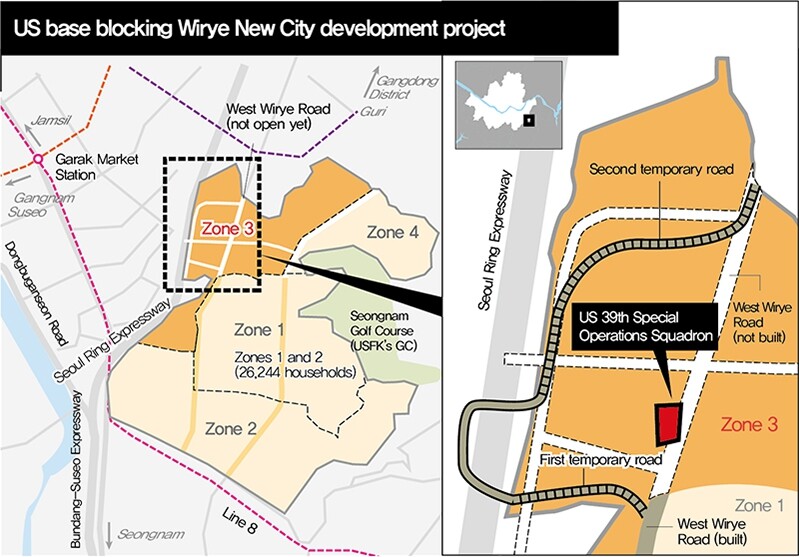hankyoreh
Links to other country sites 다른 나라 사이트 링크
US military base in Seoul is blocking the development of Wirye New City

The Wirye New City development project in Seoul’s Songpa district is facing setbacks due to the presence a US Forces Korea base site, it was confirmed.
The base’s location on what is planned to be a key road site means that even if apartment construction is completed, the road cannot be opened until environmental discussions and other base return procedures have been completed.
The situation is causing growing inconvenience for residents and ballooning project costs. But the biggest issue may be that even the company behind the project and the local lawmaker were unaware of the presence of a US base operating on Ministry of National Defense land in the Wirye area. It’s a case of the military’s fixation on secrecy getting in the way of a systematic response even on a large-scale government project.
The Seoul Housing and Communities Corporation (SH), which is in charge of Zone 3 of the Wirye housing land development project, was confirmed on July 27 to be taking measures after recently publishing an internal report citing “setbacks in the construction of the West Wirye Road currently being pursued for the convenience of Wirye New City residents traveling in the direction of Geoyeo [a neighborhood in Seoul] due to a US military base within the area.”

Complaints about travel inconvenience have been flooding in since the first half of 2016 from residents of the neighboring complexes, which have been open since 2013. But the prevailing view is that even temporarily opening West Wirye Road by the delayed target date of Dec. 2017 is likely to be out of the question. As seen with the relocation effort for US Forces Korea bases, the return of bases requires environmental discussions with the US to assess hazard and undertake cleanup efforts — and those discussions have failed to gain traction due to the US military’s attempts to dodge responsibility. Incompetence and helplessness from the Ministry of National Defense, Ministry of Environment, and Ministry of Foreign Affairs and Trade have also played a part. Indeed, the Wirye base site has never received an on-site visit by the Ministry of Employment and US military in the full year since the relocation.
SH finally opted in Dec. 2016 to open up a temporary road horizontally toward the Munjeong neighborhood in Songpa district, and another temporary road vertically toward Geoyeo this June. The cost was around 600 million won (US$536,000). Once West Wirye Road is actually built, the temporary roads will need to be uprooted and the land restored to its original greenbelt role. Residents are still bypassing Geoyeo, which should be a 5- to 10-minute distance away.
Approved in 2008, the Wirye New City project was scheduled for completion in 2017. The project coincided with the relocation of the seven South Korean military units (including the Special Forces, Defense Security Unit, Athletic Corps, and Army Administrative School) that chiefly occupied the 6.77 million square meter site. But Zone 3, which is closest to the Jamsil and Gangnam areas, ended up bogged down. The relocation of the Special Forces Command and other units at the site was delayed due to complaints from the new site in Icheon, Gyeonggi Province.
Originally scheduled for 2014, the official relocation of the Special Forces Command happened in Aug. 2016. The SH construction project took on a greater sense of urgency, as the delays resulted in complaints beginning to pour in during the first half of that year.
Currently, there is no road vertically connecting the 26,000 households (19,000 as of 2016) in Zones 1 and 2 (built by the Korea Land and Housing Corporation [LH]) — who began taking up residence in 2013 — with the rest of Seoul. Calls for the opening of the 2-kilometer West Wirye Road became more urgent. All that had to be done was to add another 900 meters within Zone 3.
But in carrying out the road project, SH was hit by a bolt from the blue with the US military base issue.
“While we were carrying out the military base demolition and earth work last December, the Ministry of National Defense notified us that a US base could only be torn down after donated property return procedures were completed according to SOFA [the Status of Forces Agreement],” a source with the construction project explained. “Neither we nor LH, which was in charge of the overall project, had any idea there was a US base there.”
It was the site of the US 39th Special Operations Squadron, which supports strategy and tactical training for South Korea’s special forces units during wartime. It had been using 7,000 square meters of state-owned land before relocating to Icheon last year with the South Korean Special Forces Command. Since then, the site had remained as US military land with no US troops on it.
Zone 3 is scheduled for completion in 2019. But a worst-case scenario in which environmental contamination is discovered on the site and environmental discussions drag out due to questions about who is responsible for the cleanup could result in an apartment complex being built with no road access. Camp Long in Wonju, Gangwon Province, has remained unreturned for over six years since its relocation due to cleanup issues; the return of the Defense Reutilization and Marketing Office (DRMO) site in Busan took over ten years to happen.
“Because this was a unit involved in allied wartime operations with the Special Forces Command, the relocation was made to coincide with the circumstances and schedule of the South Korean military’s relocation,” the Ministry of National Defense explained.
The ministry also said it had “sent official notice to the Ministry of Environment in late February of this year asking for an environmental assessment for its return.”
The Ministry of Environment said it had “received and is currently examining a document containing basic environmental information about the site in question [facility status] that was received from the US military in English.”
“Since there is also a negotiation stage with the Ministry of National Defense and Ministry of Foreign Affairs after the environmental discussions, we cannot talk about the base being returned within the year,” the ministry said.
There is no way of knowing what other unknown US military units might be present in South Korea. LH performed an environmental impact assessment in 2009 as part of the early residential land development procedure for Wirye, but said it had no idea of the base’s presence at the time. This means it is very likely to have been left out of the assessment. The Ministry of Environment, for its part, completed its discussions without requesting supplementary action in connection with it.
“There are two oil facilities within the Wirye US military base, but their storage capacity appears to be small,” said the Ministry of Environment.
“It appears that only facilities with 20,000 liters or more were investigated as targets for special land contamination management.”
The office of Minjoo Party lawmaker Nam In-soon, who represents the area, said, “This is a state project and the transportation issues are severe, yet we were unaware there was even a US military base in Songpa.” It’s another example of South Korea finding its hands tied as a result of US military bases.
By Lim In-tack, Cho Il-jun and Lim Ji-sun, staff reporters
Please direct questions or comments to [english@hani.co.kr]

Editorial・opinion
![[Column] Season 2 of special prosecutor probe may be coming to Korea soon [Column] Season 2 of special prosecutor probe may be coming to Korea soon](https://flexible.img.hani.co.kr/flexible/normal/500/300/imgdb/original/2024/0426/3317141030699447.jpg) [Column] Season 2 of special prosecutor probe may be coming to Korea soon
[Column] Season 2 of special prosecutor probe may be coming to Korea soon![[Column] Park Geun-hye déjà vu in Yoon Suk-yeol [Column] Park Geun-hye déjà vu in Yoon Suk-yeol](https://flexible.img.hani.co.kr/flexible/normal/500/300/imgdb/original/2024/0424/651713945113788.jpg) [Column] Park Geun-hye déjà vu in Yoon Suk-yeol
[Column] Park Geun-hye déjà vu in Yoon Suk-yeol- [Editorial] New weight of N. Korea’s nuclear threats makes dialogue all the more urgent
- [Guest essay] The real reason Korea’s new right wants to dub Rhee a founding father
- [Column] ‘Choson’: Is it time we start referring to N. Korea in its own terms?
- [Editorial] Japan’s rewriting of history with Korea has gone too far
- [Column] The president’s questionable capacity for dialogue
- [Column] Are chaebol firms just pizza pies for families to divvy up as they please?
- [Column] Has Korea, too, crossed the Rubicon on China?
- [Correspondent’s column] In Japan’s alliance with US, echoes of its past alliances with UK
Most viewed articles
- 1Samsung subcontractor worker commits suicide from work stress
- 2‘We must say no’: Seoul defense chief on Korean, USFK involvement in hypothetical Taiwan crisis
- 3Is Japan about to snatch control of Line messenger from Korea’s Naver?
- 4Division commander ordered troops to enter raging flood waters before Marine died, survivor says
- 5[Editorial] Korea’s surprise Q1 growth requires objective assessment, not blind fanfare
- 6No good, very bad game for Korea puts it out of Olympics for first time since 1988
- 7US overtakes China as Korea’s top export market, prompting trade sanction jitters
- 8Korea’s 1.3% growth in Q1 signals ‘textbook’ return to growth, says government
- 9N. Korean delegation’s trip to Iran shows how Pyongyang is leveraging ties with Moscow
- 10[Column] Season 2 of special prosecutor probe may be coming to Korea soon